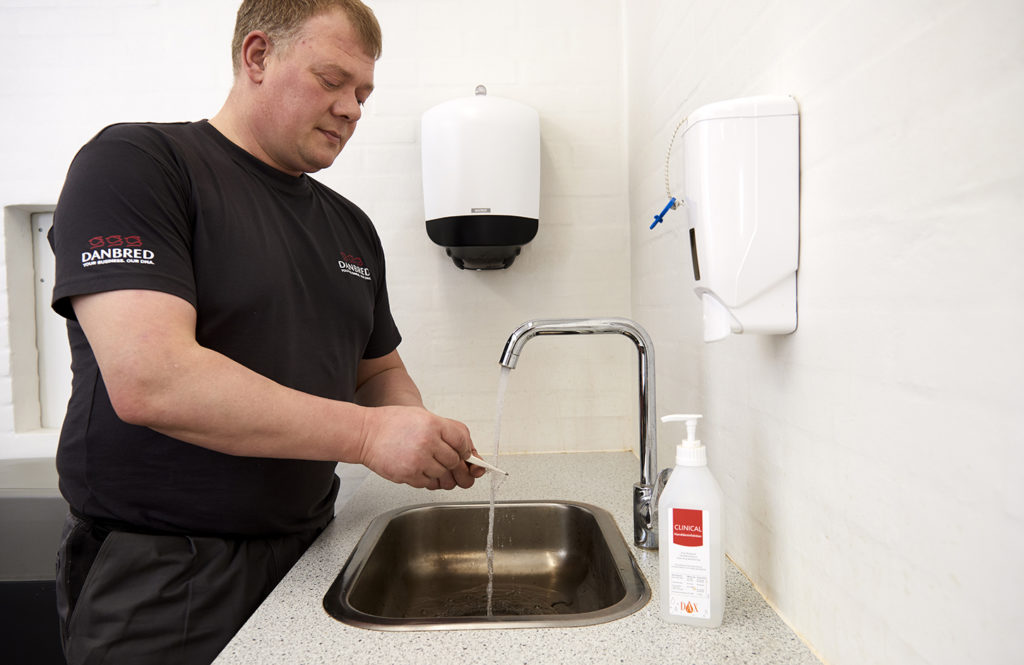Cleaning practice – secure semen quality
Content
Correct cleaning practice will preserve semen quality
Cleaning and disinfection are a corner stone in semen quality - focusing on correct cleaning practice is imperative to preserving the high-quality and shelf life of DanBred semen.
How to finish a successful day of collection
Quality of semen is of the highest importance to unlock of full genetic potential that DanBred offers. Hygiene in particular is fundamental, and the introduction of a clearly defined hygiene protocol focusing on cleaning procedures at the end of the working day will greatly influence how the next day will start, work flow, efficiency and ultimately the quality of the semen. This is vital to achieve the full value of the extraordinary potential for reproductive performance within the DanBred breeding animals.
To assure the genetic potential of the DanBred boar is achieved on a daily basis, it it imperative to focus on key areas associated with the end of day tasks, so that the targets of increased quality and reduced risk of semen contamination are met.
Maintain quality by cleaning the laboratory and collection area daily
It is a must for a well run on farm boar stud producing high-quality semen that all equipment and tools that might come into direct or indirect contact with semen is cleaned, disinfected and/or sterilised at the end of the day of collection. Reducing the risk of bacterial contamination within the semen is desirable in order to maintain the superior fertility.
Cleaning and disinfection are integral to maintaining semen quality, and focusing on correct cleaning practice is imperative to preserve the high-quality and shelf life of the DanBred semen.
It is important to properly clean and disinfect all collection equipment, as well as tools, processing equipment, the laboratory room(s) and collection area itself at the end of the day or after use. When purchasing equipment, assess the ability to disassemble and the overall ease of cleaning- this plays a major role when it comes to the time and effort needed for cleaning on a daily basis.
It is highly recommended to have protocols and schedules in place not only for daily cleaning, but also weekly and monthly along with general maintenance. Furthermore, keep a protocol on calibration schedules for the semen evaluation equipment used. Please refer to equipment manuals for specific internal and external maintenance schedules.
When purchasing disinfectants for commercial use, it is extremely important to choose a product appropriate for the bacteria that may be present in the area to be treated, particularly in the laboratory as the choice of disinfectant for laboratory equipment can affect the quality of the semen. Moreover, attention needs to be paid to the quality of water used for cleaning, the ambient temperature, concentration and exposure times in order for the cleaning agent to be effective. Please pay close attention to the manufacturers recommendations for these items.
Easy steps for the successful cleaning of collection and laboratory areas

 After each day of use, the collection and laboratory areas (and equipment) should be cleaned and disinfected.
After each day of use, the collection and laboratory areas (and equipment) should be cleaned and disinfected.
We recommended making a schedule for the daily, weekly and monthly cleaning routines and develop a positive “culture of cleaning” within your facilities.
Cleaning the laboratory and collection areas (and the equipment and tools used) should follow these key steps:
- Remove any organic material from the surfaces.
- Pre-soak with a degreaser or foaming detergent.
- High pressure wash or manually by hand to remove organic matter and biofilm.
- Rinse thoroughly with clean water at low pressure.
- Dry – being careful to avoid contamination when drying.
- Disinfect appropriate products or sterilize where applicable using proper heat and time.
References
Althouse, G.C.; C. Kuster & S.G. Clark (1998): Contaminant growth of spermicidal bacteria in extended porcine semen. Proc. 15th IPVS Congress, Birmingham, England.
Althouse, G.C., C.E. Kuster, S.G. Clark & R.M. Weisiger (2000): Field investigations of bacterial contaminants and their effects on extended porcine semen. Theriogenology, 53:1167-1176.
Rillo, S. M., V. Shokouhi, E. Garcia Boix, R. Hernandez-Gil & L. Romero (1998): Contamination of semen doses and its possible relationship with the bacterial flora of the prepuce. Proc. 15th IPVS Congress, Birmingham, England.




